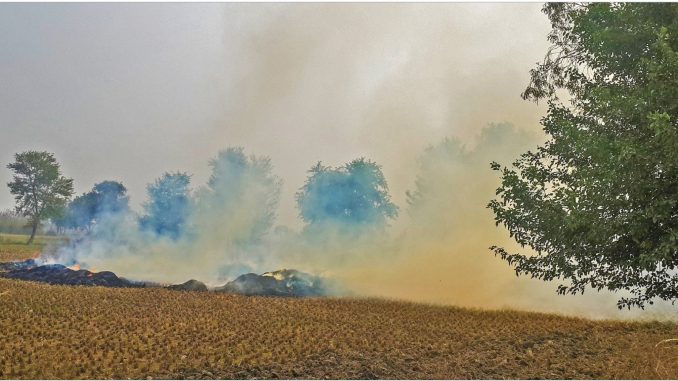
Air pollution has risen to acute levels in the National Capital Region (NCR) and adjoining areas. This spike is being attributed in large part to the burning of crop residue by farmers in Punjab and Haryana. Such burning of crop residue is undertaken every year by the cash-strapped farmers in order to save on costs and time for sowing the rabi crop. According to the Environment Pollution (Prevention and Control) Authority, approximately 35 million tonnes (mt) of stubble is burnt in Punjab and Haryana just before the onset of winter. The central and state government agencies are aware of this practice, but have not been able to prevent its repeated occurrence. However, more recently, both public and private sector companies have been making efforts to come up with a viable solution to end the practice of crop burning.
Public sector approach
In a bid to reduce the pollution caused by the burning of crop residue, the government, in November 2017, directed the state-run power producer, NTPC Limited to add crop residue pellets along with coal in its thermal power plants (TPPs). NTPC will add up to 10 per cent of crop residue pellets in its plants. However, this is not a clean solution as pollutants from TPPs add to air pollution.
In August 2017, the Haryana Renewable Energy Development Agency issued a request for proposals, inviting bids from biomass project developers to set up paddy straw-based power projects in the rice belt of Haryana. Being an agriculturally rich state, Haryana has an abundance of crop residue. Of the total biomass available, some is used for various rural applications while some biomass forms (such as paddy and wheat straw) are burnt. This surplus biomass can be used for power generation, for both captive industrial use as well as grid supply.
For now, six projects of 5-15 MW capacity each have been proposed to be set up on a pilot basis in Ambala, Karnal, Kurukshetra, Jind, Kaithal and Fatehabad districts, with a total aggregate capacity of 50 MW. The projects will be based on Rankine cycle technology with air-cooled condensers. As per the incentives provided by the Ministry of New and Renewable Energy for biomass projects, a capital subsidy of Rs 2 million per MW can be availed of, subject to a cap of Rs 15 million per project. These projects will be placed under the “Industry” category of the Industrial Policy, 2005, which will entitle them to all the incentives given to new projects as per the policy.
Commercial case for the private sector
A number of private players have entered the bioenergy-based power generation space, more so from the point of view of commercial viability of this model. One such company is Sampurn Agri Ventures Private Limited (SAVPL).
SAVPL, in collaboration with the Indian Institute of Technology, Delhi, has developed a proprietary technology to ferment paddy straw for the large-scale generation of clean energy in the form of biogas. According to the company, around 500 mt of crop residue, which can be used to produce 57.5 mt of compressed natural gas (CNG) valued at Rs 2 trillion, is wasted every year.
SAVPL’s business model is simple. The company purchases paddy straw from farmers and feeds it into anaerobic digesters for composting. On composting the paddy, biogas is produced along with enriched acidic slurry and organic manure. Biogas is a source of renewable energy and can be used to generate clean power.
The company’s first biogas-based power plant, operational in Fazilka, Punjab, generates nearly 4,000 cubic metres of biogas using 10 tonnes of paddy straw daily. This biogas, in turn, is used to generate 1 MW of power. The plant was installed in seven to eight months. The total outlay for the plant was around Rs 170 million. Currently, the company is utilising the biogas to generate power as it lacks the infrastructure needed to transport the resource for other uses.
Apart from biogas, two other essential products are formed in the process – a sulphur-rich pH balancer and rice straw compost. The sulphur-rich pH balancer, named Kudrat Alkafin, is primarily dilute sulphuric acid extracted organically from biogas, which can be used for alkaline soil. Since it is extracted indirectly from paddy straw, the product is inherently abundant in macro and micronutrients. According to the company, Alkafin has been prepared keeping in mind the extremely alkaline soils of Punjab and Haryana. Prepared with a controlled pH value of less than 7, Alkafin acts as a growth booster.
Meanwhile, the rice straw compost is used as a base to produce bio-enriched organic manures. According to the company, these are the only manures in the country that are rich in plant-soluble silica, which is essential for the plant’s healthy life. This range of manures is also steamed before packaging to get rid of any impurities. These manures are superior to farm yard manures as they have a higher content of absorbable silica and potassium, up to five times the water holding capacity, macronutrients and the ability to battle plant toxicity. According to Sanjeev Nagpal, founder and chairman, SAVPL, the infusion of this manure reduces the input of other urea-rich manures by up to 75 per cent. Further, Alkafin and the organic manure together have proven to increase yield by up to 20 per cent.
The company has plans to scale up operations by setting up 42 such projects, covering every district in Punjab. These pilot projects are expected to be operational by the paddy harvesting season of 2018. Each of these projects will process roughly 70 tonnes of paddy straw per day and employ 30 individuals, mainly for the collection and management of paddy straw. The company also plans to build infrastructure for CNG distribution. The total outlay for such an expansion has been estimated at Rs 30 billion and it is expected to be completed in the next three years.
SAVPL has signed an MoU with Indian Oil Corporation Limited (IOCL), as per which, IOCL will procure the CNG produced from these plants. IOCL has agreed to extend the contract to any developer using the technology developed by SAVPL.
The company procures the paddy straw at Rs 2 per kg, which will add roughly Rs 60 billion to the rural economy while also creating Rs 50 billion worth of man hours. Further, it will help save Rs 60 billion on petroleum imports.
As appealing as the above proposition may sound, it is not without its limitations and shortcomings. A major caveat is that these projects are small scale and cater to local areas. These cannot be implemented on a large scale. Due to the high logistical costs involved in transporting paddy straw and distributing the produced manure, large-scale projects are not viable, making small plants catering to small areas preferable. These plants handle crop residue in the range of 20-70 tonnes and distribute its products in the same area.
Securing financing for these projects is another challenge. As these projects are currently being developed on a pilot basis, the financiers are cautious of investing in them. The scenario does not seem so bright in the near future as well and it may take a while for financiers to come around and develop confidence in these projects. Further, despite its benefits, the manure produced by the company is still a new product. Whether farmers will actually prefer it over existing manures remains highly unpredictable owing to the lack of room for trial and error. The lack of adoption could be a major obstacle for the company if revenue from these products has been considered as a factor while evaluating the economic viability of these projects.
The way forward
SAVPL has a difficult journey ahead, which involves proving its business model and creating a place for itself in the market. The company would have to educate the farmers about these products to increase their adoption. Further, supply chain management and storage issues will have to be managed efficiently given the perishable nature of crop residue. SAVPL has set out to establish a niche market, pushing the envelope at a time when there is a desperate need for sustainable and clean energy, while also mitigating the adverse effects of stubble burning on the environment.



